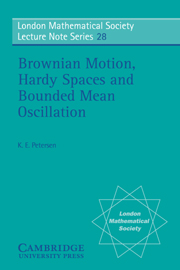Book contents
- Frontmatter
- Contents
- Preface
- 1 Introduction
- 2 The maximal, square and Littlewood-Paley functions
- 3 Brownian motion
- 4 Distribution equivalence of the two maximal functions
- 5 Inequalities for the conjugate function
- 6 The maximal function characterization of Hp
- 7 The martingale versions of HP and BMO
- References
- Index
- Frontmatter
- Contents
- Preface
- 1 Introduction
- 2 The maximal, square and Littlewood-Paley functions
- 3 Brownian motion
- 4 Distribution equivalence of the two maximal functions
- 5 Inequalities for the conjugate function
- 6 The maximal function characterization of Hp
- 7 The martingale versions of HP and BMO
- References
- Index
Summary
The purpose of this chapter is to define and construct Brownian motion and to list enough of its properties so that we will be able to carry out the subsequent arguments which rely on them. We omit most proofs and suggest that the interested reader refer to [14, 18, 20, 27, 34, 36, 40, 43, 44, or 58] for more details.
The strange spontaneous movements of small particles suspended in liquid were first studied by Robert Brown, an English botanist, in 1828, although they had apparently been noticed much earlier by other scientists, including even Leeuwenhoek. L. Bachelier gave the first mathematical description of the phenomenon in 1900, going so far as to note the Markov property of the process. In 1905 A. Einstein and, independently and around the same time, M. v. Smoluchowski developed physical theories of Brownian motion which could be used, for example, to determine molecular diameters. It is interesting that Einstein says that at that time he had never heard of the actual observations of Brownian motion, and that he happened to deduce the existence of such a process in the course of some purely theoretical work on statistical mechanics and thermodynamics [50, p. 47], The mathematical theory of Brownian motion was invented in 1923 by N. Wiener, and accordingly the Brownian motion that we will be working with is frequently called the Wiener process.
- Type
- Chapter
- Information
- Publisher: Cambridge University PressPrint publication year: 1977



